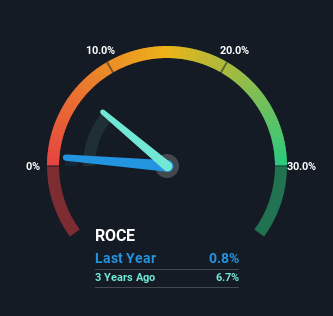- United States
- /
- Interactive Media and Services
- /
- NasdaqGS:BMBL
Be Wary Of Bumble (NASDAQ:BMBL) And Its Returns On Capital

To find a multi-bagger stock, what are the underlying trends we should look for in a business? Firstly, we'd want to identify a growing return on capital employed (ROCE) and then alongside that, an ever-increasing base of capital employed. Ultimately, this demonstrates that it's a business that is reinvesting profits at increasing rates of return. However, after investigating Bumble (NASDAQ:BMBL), we don't think it's current trends fit the mold of a multi-bagger.
Understanding Return On Capital Employed (ROCE)
For those that aren't sure what ROCE is, it measures the amount of pre-tax profits a company can generate from the capital employed in its business. Analysts use this formula to calculate it for Bumble:
Return on Capital Employed = Earnings Before Interest and Tax (EBIT) ÷ (Total Assets - Current Liabilities)
0.0079 = US$28m ÷ (US$3.7b - US$209m) (Based on the trailing twelve months to March 2023).
So, Bumble has an ROCE of 0.8%. Ultimately, that's a low return and it under-performs the Interactive Media and Services industry average of 8.1%.
Check out our latest analysis for Bumble

Above you can see how the current ROCE for Bumble compares to its prior returns on capital, but there's only so much you can tell from the past. If you'd like, you can check out the forecasts from the analysts covering Bumble here for free.
SWOT Analysis for Bumble
- Debt is well covered by cash flow.
- Interest payments on debt are not well covered.
- Expected to breakeven next year.
- Has sufficient cash runway for more than 3 years based on current free cash flows.
- Trading below our estimate of fair value by more than 20%.
- No apparent threats visible for BMBL.
The Trend Of ROCE
When we looked at the ROCE trend at Bumble, we didn't gain much confidence. To be more specific, ROCE has fallen from 21% over the last four years. However, given capital employed and revenue have both increased it appears that the business is currently pursuing growth, at the consequence of short term returns. And if the increased capital generates additional returns, the business, and thus shareholders, will benefit in the long run.
On a related note, Bumble has decreased its current liabilities to 5.6% of total assets. Considering it used to be 63%, that's a huge drop in that ratio and it would explain the decline in ROCE. What's more, this can reduce some aspects of risk to the business because now the company's suppliers or short-term creditors are funding less of its operations. Since the business is basically funding more of its operations with it's own money, you could argue this has made the business less efficient at generating ROCE.
The Bottom Line On Bumble's ROCE
Even though returns on capital have fallen in the short term, we find it promising that revenue and capital employed have both increased for Bumble. And there could be an opportunity here if other metrics look good too, because the stock has declined 47% in the last year. As a result, we'd recommend researching this stock further to uncover what other fundamentals of the business can show us.
While Bumble doesn't shine too bright in this respect, it's still worth seeing if the company is trading at attractive prices. You can find that out with our FREE intrinsic value estimation on our platform.
For those who like to invest in solid companies, check out this free list of companies with solid balance sheets and high returns on equity.
Valuation is complex, but we're here to simplify it.
Discover if Bumble might be undervalued or overvalued with our detailed analysis, featuring fair value estimates, potential risks, dividends, insider trades, and its financial condition.
Access Free AnalysisHave feedback on this article? Concerned about the content? Get in touch with us directly. Alternatively, email editorial-team (at) simplywallst.com.
This article by Simply Wall St is general in nature. We provide commentary based on historical data and analyst forecasts only using an unbiased methodology and our articles are not intended to be financial advice. It does not constitute a recommendation to buy or sell any stock, and does not take account of your objectives, or your financial situation. We aim to bring you long-term focused analysis driven by fundamental data. Note that our analysis may not factor in the latest price-sensitive company announcements or qualitative material. Simply Wall St has no position in any stocks mentioned.
About NasdaqGS:BMBL
Bumble
Provides online dating and social networking applications in North America, Europe, internationally.
Undervalued with adequate balance sheet.
Similar Companies
Market Insights
Community Narratives





